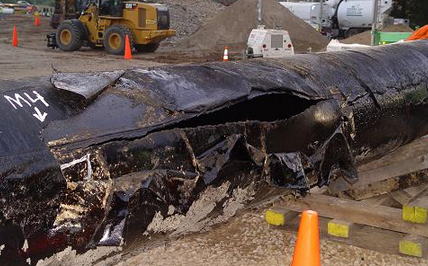Dozens of environmentalists gathered at Hamilton, Ontario's City Hall to protest a major pipeline project, know as the Enbridge Line 9 reversal, on Wednesday October 17th. They gathered outside and then made deputations at a city council meeting where a report on the project was being presented to councillors.
The pipeline currently brings oil from Montreal to Sarnia, Ontario, passing through Hamilton along the way. Environmentalists fear that the plan to change the direction of flow would allow tar sands oil to be pumped to the east coast for export—a claim which Enbridge denies.
In May 2012, opponents of the reversal disrupted a National Energy Board (NEB) hearing on whether to allow the project. The NEB later approved the project.
Since then opposition has been growing in First Nations communities and Southern Ontario cities. Last month a speaking tour of First Nation women spoke about the pipeline in several venues across the region.
"I think it is a disaster waiting to happen, to allow Enbridge to pump diluted bitumen through this pipeline," said Ken Stone, a member of 350.org, to Hamilton city council. "It is important for councillors to think what would happen if the pipeline burst."
In 2010 a pipeline very similar to Line 9 ruptured in Kalamazoo Michigan, spilling 3 million liters of diluted bitumen into the Kalamzoo River.
A smaller pipeline rupture took place in Hamilton in 2001, spilling 95,000 liters into a farmer field.
Although opponents of the pipeline acknowledged that with federal slashing of environmental reviews processes it is important for municipalities to study the impacts of the pipeline, they were disappointed with Hamilton city staff’s analysis.
"In the report they don't talk about the climate change once, or the detrimental effects of the tar sands," said activist Elysia Petrone. She believes the city staff simply agreed with the NEB findings.
"I think Enbridge is being dishonest and not explaining what their true intentions are."
Enbridge was invited to speak to Hamilton's council about the matter, but they rescheduled twice before finally cancelling their appearance. However, several councillors said Enbridge had approached them personally in off-the-record discussions.
After hearing from opponents to the plan, several city councillors voiced their fears about the pipeline project. City staff admitted they too had concerns but said the chances of a spill were unlikely and that the City of Hamilton did not have a lot of influence over the project.
"My community is already heavily destroyed from industry; we don't need any more," said Vanessa Gray, a First Nations youth from Aamjiwnaang, a community just outside of Sarnia, Ontario, who travelled to Hamilton for the protest.
“It is important that those on the front lines come out to support each other," she told the Toronto Media Co-op.
The first phase of the project will reverse the pipeline between Sarnia and Hamilton.
However, the campaign against the pipeline reversal is expected to grow, as the second phase of the project will see the reverse the flow of the pipeline between Hamilton and Montreal, and will pass through several cities including Toronto, the largest metropolis in the country.
Tim Groves is an investigative researcher and journalist based in Toronto. He can be reached at timgrovesreports [@] gmail.com. For more information on his work and writing, click here.
